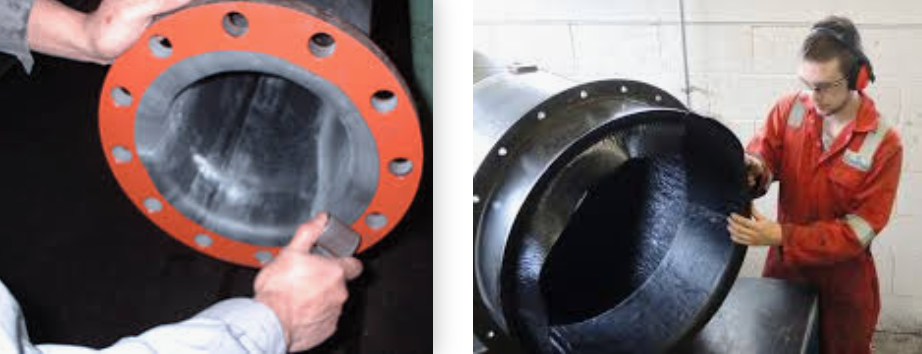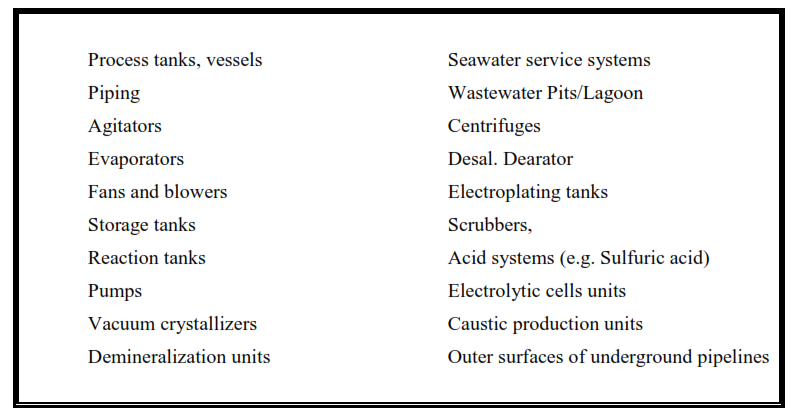Rubber lining is an effective means for protecting metal from many chemical environments. Selected and installed correctly and properly maintained, it can provide protection for long periods of time. The proper installation of rubber lining for the protection of tanks, piping, and specialty equipment containing harsh chemicals and acid is important to ensure that the lining will provide trouble free service for the life of the equipment.
GUIDELINES FOR INTERNAL RUBBER LINING
Typical areas where sheet rubber lining is utilized involve environments that have chemical attack and abrasion. These include storage tanks, process
vessels, piping, power plant scrubbers, seawater heat exchanger shells, and numerous other pieces of equipment. Proper materials selection and the development of an application specification are the first steps in assuring the quality of the sheet rubber lining product.

A detailed surface preparation and application specification is necessary to assure the quality of the installation. Technical organizations such as the Rubber Manufacturers Association (RMA) and sheet rubber manufacturers offer model specifications for various types of sheet rubber lining products.
Data on the history of the material in specific service environments is available from material suppliers. They also offer information on applicators that have a history with the material, service environment and application conditions. All of these items are useful in the material and contractor selection process and must be taken into consideration in the preparation of this guideline.
Rubber linings have successfully been used in every industry that has had a corrosion and/or abrasion problem. Here is a sampling of applications:

The philosophy shall ascertain correct selection of internal lining requirements for projects. This section shall apply for only polymer (rubber) linings. The applicable procedures for paints internal linings systems are given in the appropriate sections of this manual.
Technical Requirements of Rubber Materials
Cost effective and technically feasible lining materials and thicknesses for a given set of operating parameters, design life, desired performance, etc. shall be recommended and established. The recommendation shall be based on a review of the standard lining products available in the market and on experience and from external sources.
The FS “functional requirements” principle shall form the basis for product reviews, and the “lowest LCC” principle shall apply during cost comparisons.
Definitions
LCC “Life Cycle Cost”, including investment costs (procurement, fabrication, installation and commissioning costs), and discounted future costs (inspection,
maintenance, operation, replacement costs).
FS “Functional Specification” (functional requirements specification)
Proper qualities of lining materials shall be used, and the lining shall be applied according to well established procedures, to ensure that the lining performs satisfactorily during its entire design life.
Normally, “a satisfactory performance” is identical to “meeting the liner material suppliers recommended values regarding mechanical testing and other properties”.
The desired mechanical properties and corrosion resistance must be given careful consideration in the proper selection of the particular sheet rubber lining to be applied. Conditions such as chemical solutions and operating and design temperatures all effect the materials selection. The vendor of lining must provide the performance data relating to various conditions that can aid in proper materials selection.
The selected lining system shall be reviewed by affiliate‟s responsible representative(s) prior to coating application.
For rubber linings only: A lining repair procedure shall be submitted to the affiliate‟s responsible representative(s) for approval prior to start of lining application activities. If rubber linings are to be used the repair procedure shall include repair of both un-vulcanized and vulcanized rubber lining
material. BS 6374: Part 5, Section 7 (in the 1985 edition), may serve as the basis for the repair procedure.
Adhesion
For polymer (rubber) linings, qualification of procedures may include adhesion testing. If a procedure that includes adhesion testing is used, the quality control adhesion testing may be considered optional. Relevant adhesion test results obtained during the last two projects performed by the lining applicator may be referred to in lieu of performing adhesion testing.
If quality control adhesion testing is performed during lining application the minimum individual adhesion value shall not be less than 90% of the average of all values from the last two projects.
Chemical compatibility
The performance of the rubber lining shall not be reduced due to chemical or other degradation from the environment to which the liner will be exposed.
When potable water tanks are lined, the rubber lining system shall not reduce the quality of the potable water, e.g. result in human health hazard. Lining of potable water equipment shall be performed in compliance with Saudi relevant health authority standards.
Resistance to cathodic disbanding
The rubber lining performance shall not be reduced due to the presence of a cathodic protection system (e.g. sacrificial anodes).